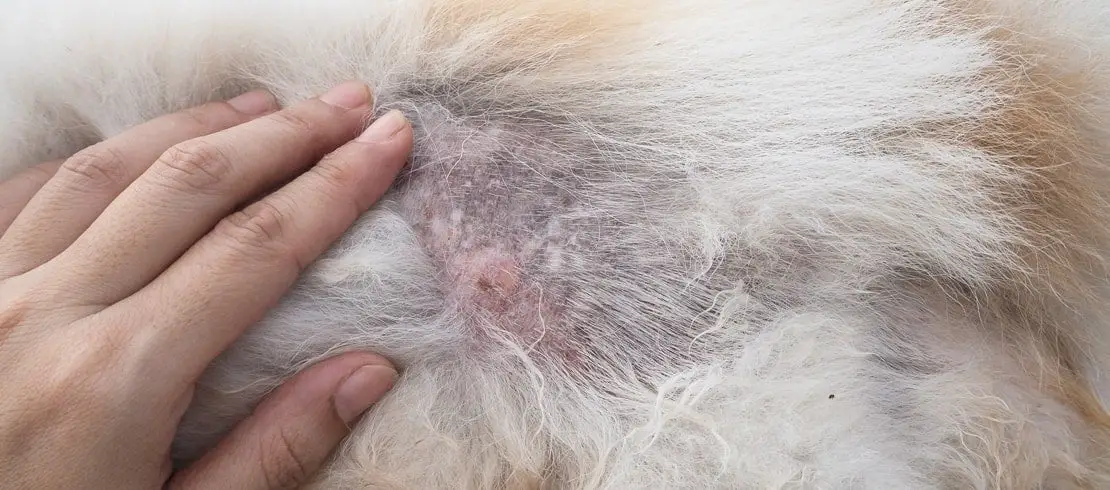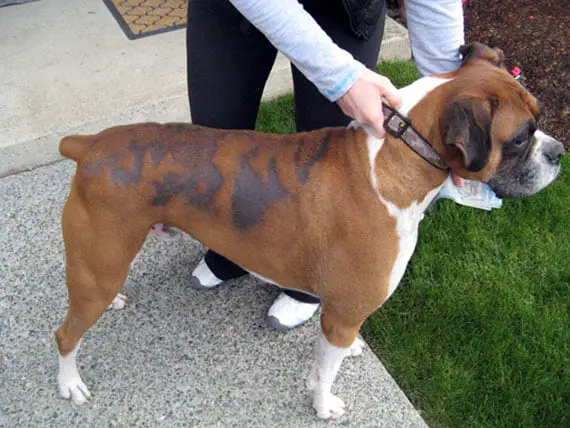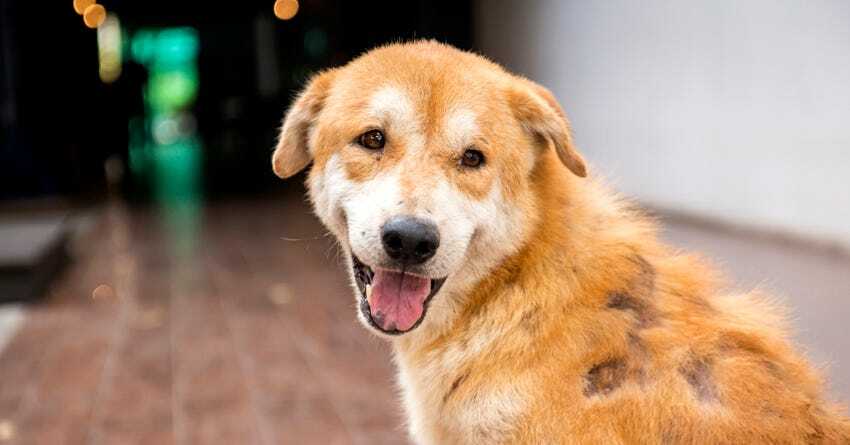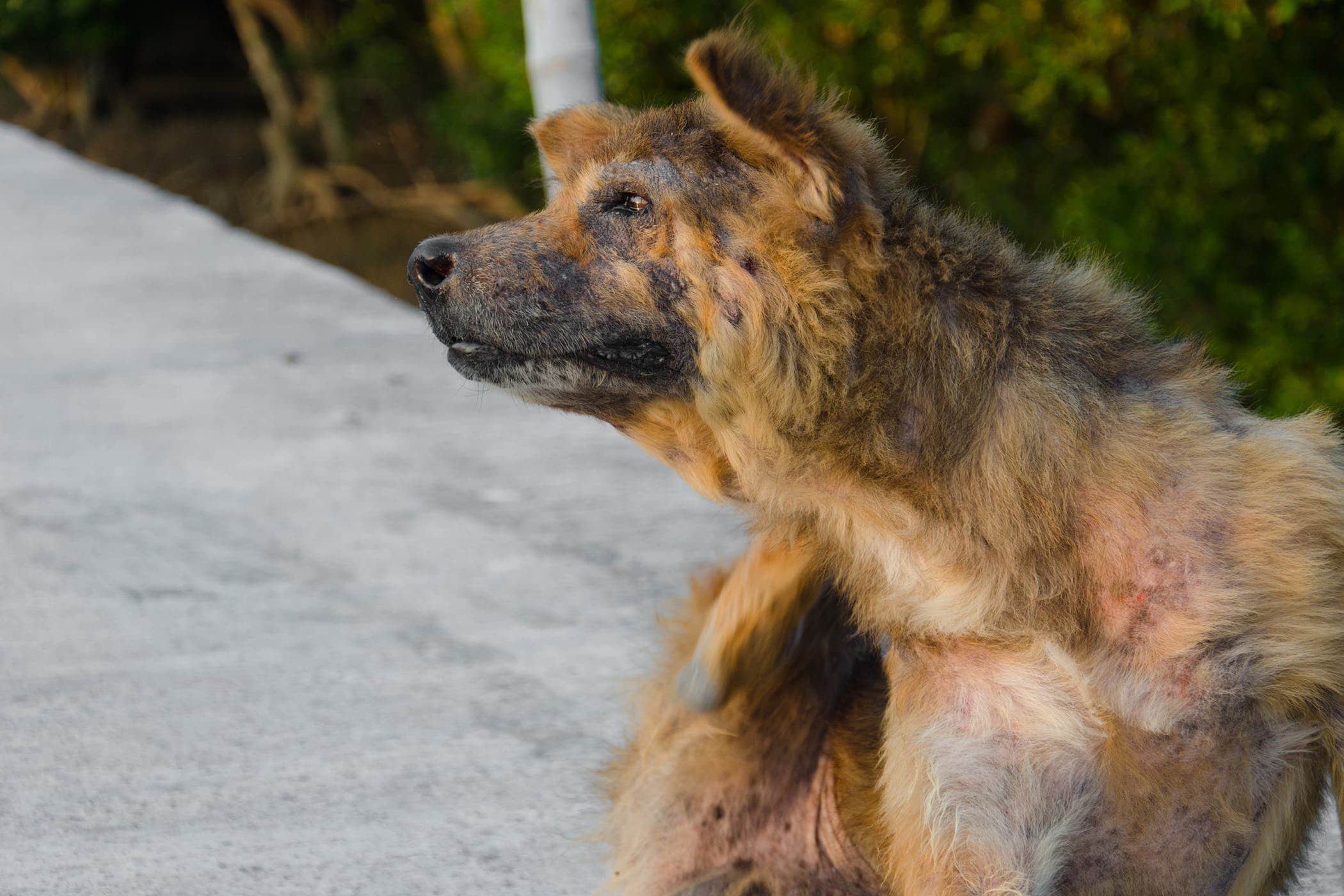Table of Contents
Dogs Losing Hair- Here’s All You Need To Know!
Dogs losing hair in patches or single spots can be frightening for the owner. Hair loss in canines is also known as alopecia. It is incredibly noticeable and common. If you notice dogs losing hair at home, you may be worried and searching for proper treatment. Before jumping on to the treatment, there are a few causes you must know.
Given below are details to find out more about your dogs losing hair.
Dogs losing hair- symptoms

Alopecia or dog hair loss is an apparent condition that may occur in any breed, at any age, and anywhere on the dog’s body. You may notice various symptoms and patterns developing on the dog’s body as per the underlying causes of dogs losing hair.
- Thinning of all the hair.
- Hair loss around mouth and eyes.
- Complete hair loss patches.
- Symmetrical patterns of hair loss on both sides of the dog’s body.
- Itchiness.
- Foul odor.
- Dark grey or black skin appearance under hair loss.
- Scaly and dry skin around the area of hair loss.
- Inflamed and red skin around the hair loss region.
- Bleeding or oozing moisture around the hair loss area (this is typically a secondary condition).
Causes of dog losing hair
There are a few causes why your dog is losing hair. Below given are some important and common causes of hair loss on dogs.
1. Seasonal shedding

Sometimes, extreme hair loss on dogs is just a part of seasonal shedding. When the individual hair becomes damaged and old, the dogs may lose fur. Also, when the weather turns warm seasonally, the dogs lose hair.
Many breeds shed year-round. For instance, a few species, labradors and huskies, grow a thick undercoat in winter and shed during spring. You can reduce seasonals shedding in your dog if you reside in a moderate climate instead of extreme ones. If season shedding grows out of control in your dog, brushing a few times a week will help remove and manage excess hair.
2. Fungal and bacterial infections
Yeast and bacteria are regular inhabitants of your dog’s skin, but at times they may spread out of control and develop an infection. Fungal or bacterial yeast infections on the dog’s skin might lead to hair loss, itching, redness, and odor. Sometimes, conditions lead to pimple-like bumps on the body.
Dogs can also catch ringworm, a particular fungus that leads to immense hair loss and tiny patches of infection. Red, scaly or itchy patches are frequent causes for a visit to the vet. Your vet will carry a complete examination, suggest some analysis, and order antifungals or antibiotics to manage the disease if required.
3. Parasites
Mange is one catch-all title for itching skin infections produced by mites. Mites are minute creatures that reside on the skin surface or inside the hair follicles. They induce hair loss and stimulate itchy skin by burrowing deep or chewing onto the skin. A few mites, for example, scabies mite, are remarkably poisonous to both owners and dogs. Additional mites, like Demodex mites, do not spread much but still lead to the dogs losing hair and might need treatment.
Fleas are also a prevalent cause for dogs losing hair. Fleas might make dogs’ skin itchy to the extent of scratching the hair off in various body parts. Fleas and mites are highly contagious. Therefore any parasites you locate on the dog might have already reached your home and another pet. If you discover any pieces of evidence of fleas or mites, the vet can order a fast-acting antiparasite medicine and give tips for clearing your house of such pests.
4. Allergies
Dogs may also disclose allergies similar to humans, and some common symptoms are the dog losing hair, itchy skin, and having itchy skin. The most prevalent allergies in dogs include atopy (environmental allergies to certain irritants like dust, mold, and pollen mites), food allergies, and flea allergies. If the vet speculates allergies, they might suggest flea control, medicine to manage the itching, preventing allergens, or a diet change to govern food allergies.
The vet will only know food allergies by carrying out a food trial for at least eight weeks. Suppose the vet sets your dog on a food analysis with a restricted-ingredient diet plan or any hypoallergenic prescription meal. It is essential to make sure that dogs do not consume anything except food while on the experiment.
A single treat or just a stolen bite of chicken may blend the results. If the underlying reason for the dog losing hair is allergies and they are operated properly, the dog’s coat must grow once again, and the itching will also stop.
5. Underlying medical conditions
If dogs losing hair is shedding it all over the body, it might be an underlying internal issue. The skin is the largest organ of the body, and it needs enormous amounts of nutrients to remain in a healthy condition. If the dog has a hidden medical ailment, the hair and coat are usually the first to endure any damage because the body starts shifting resources apart from the skin or fur and toward the inner organs that require help.
Hormonal conditions such as growth hormone disorders, adrenal gland disorders, or hypothyroidism may lead to dogs losing hair. A few dogs may lose hair following they are neutered because of a reduction in testosterone.
Kidney disease, liver disease, and cancer can also lead to unexplained loss of hair. Suppose the vet speculates an internal predicament as a cause for the dog losing hair. In that case, they might suggest laboratory testing and perhaps ultrasound or x-ray imaging to discover the precise cause.
6. Genetics
There are a few breeds of dogs that are genetically inclined to early baldness compared to other species. Primarily, dogs with no hair have been reproduced for quality, such as the American Hairless Terrier, Mexican Hairless (Xolo), and Chinese Crested. Additional dog breeds, like the Doberman Pinscher, Chihuahua, Italian Greyhound, Dachshund, and Whippet, at times, undergo patchy baldness or pattern baldness on their outer ear, lower neck, chest, back, and thigh.
7. Cushing’s disease
Dogs losing hair may also result from hyperadrenocorticism, also known as Cushing’s disease, a disease produced by the excess production of cortisol hormone. Medicine and sometimes operation is suggested to cure Cushing’s disease, which is also referred to as Cushing’s syndrome.
Cushing’s disease is extra common in canines six years and older. Additional symptoms of Cushing’s disease are eating, urinating, panting, and drinking more, as well as holding a pot-bellied shape. Take the puppy to the vet if you mark any of the mentioned symptoms with the dog losing hair.
8. Pressure sores
Heavy or older dogs may be more prone to issues like pressure sores where the dog’s elbows or different bony parts of their body come in constant contact with solid surfaces. Over a prolonged time, the average pressure thickens their skin, the hair starts to fall out, and formations of calluses are observed.
If these calluses bleed, crack, or get infected, treatment might use moisturizers, antimicrobials, or bracing. You can avoid pressure sores or calluses by giving your dog cushioned bedding.
9. Rashes
Insect stings and bites, medications, chemicals, plants, even shampoos may lead some dogs to acquire a rash or hives, resulting in dogs losing hair or getting bald spots.
Allergic hives typically appear within a few minutes to hours after exposure, and additional signs will include fever, listlessness, lack of appetite, or vomiting. Tell the vet immediately if the puppy acquires hives, as an emergency procedure might be needed.
10. Foreign body reaction
Thorns, glass, even a dog’s rough hair may all lead to inflammation and bald patches if they remain inside the dog’s skin. Besides hair loss, symptoms of irritation by a strange body incorporate licking the area frequently (like toes) and swelling. Treatment might need lancing under general or local anesthesia to eliminate the irritant and taking antibiotics if there is a subsequent bacterial infection.
Diagnosis for dog losing hair

If your dog is excessive hair loss, a vet must check it to determine the underlying reason and manage the condition as soon as possible. The analysis is based on the origin of symptoms, hair loss or baldness pattern, skin condition throughout hair loss, and if the pet is uncomfortable or itching.
- The pattern of hair loss – Hair loss may be a symptom of mange or infection from bacterias. Patches of loss might indicate diseases like ringworm, mites, or bacterial infection. Loss of hair in the tail and rump area is usually due to an allergy to fleas. Hair loss from the dog’s paws and face are generally environmental allergies (atopy). Dog losing hair symmetrically may be a symptom of adrenal gland disease, thyroid disease, unusual sex hormone levels, or endocrine disorders.
- Blood profile – Blood profile testing can help diagnose specific immune system diseases, hormone irregularities, thyroid diseases, Cushing’s disorder, or Diabetes mellitus.
- Biopsy – If any tumor or skin cancer is speculated, the vet might want to conduct a sample of the concerned area to their laboratory to ascertain diagnosis and medication.
- Skin impression smears – Holding a microscopic slide on the area affected and investigating it may show the appearance of yeast, bacteria, or inflammatory cells.
- Skin scraping – Rubbing the skin smoothly with a blade to collect hair follicles onto a thin slide will help identify the presence of mites.
- Luminescence – a few ringworm varieties will radiate a fluorescent green-yellow when kept under ultraviolet light.
- Allergen elimination trials – Maintaining hypoallergenic food, nursing fleas, or reducing the use of specific shampoos and drugs might show an allergy to a particular food.
- Allergy testing – Skin or blood tests will narrow down the record of possible environmental allergens.
Treatment for dog losing hair

Based on the analysis, several types of treatments are preset for your dog losing hair:
- Antibiotics (topical or oral) will manage bacterial infections.
- Antifungals (topical or oral) will treat ringworm and yeast infections.
- The dog might need steroids to address specific skin diseases.
- The vet might require immunosuppressive Drugs and Anti-cytokine Drugs for controlling environmental allergy (Atopy). For this, often life-long medications are needed.
- Immunotherapy might be required orally or through injection for allergy desensitization.
- The vet can suggest behavioral medications to treat nervous licking and chewing.
- Medicated shampoos and dips can manage the causes of mange.
- Hypoallergenic diets can often help resolve hair loss as a result of food allergies. Allergies to meals need some time to establish. The vet will suggest an over-the-counter or prescription hypoallergenic food and demonstrate the proper transition strategy to the current diet.
- Monthly flea prevention may help clear up hair loss connected with flea allergies.
- Thyroid medication or hormone therapy will help reverse hair loss in endocrine and hormonal disorders.
- The vet might prescribe vitamin A, Vitamin E, and fish oil supplements for pets with special conditions or a preference for skin infections and dry skin.
- The dog might need an Elizabethan collar (cone or e-collar) to limit the pet from itching or licking at the affected area until it heals completely.
- The dog might need surgery to eliminate sections of skin tumors cancer. Spaying r neutering the pet might be required for sex-hormone complications.
Hair loss as a result of chemotherapy usually clears when sessions of chemotherapy are completed. Hair loss might be changeless when produced by scarring, pressure sores, genetics, and callouses. Maximum hair loss cases, when approached correctly, will resolve. Chronic skin conditions might need ongoing treatment.
The Bottom Line
Dogs losing hair might require to be managed more than once, based on the pet’s inclination to skin diseases. Always offer treatment based on the vet’s directions. Follow-up appointments might be required to guarantee the problem is settling and any infection is resolving. Monitor the pet’s hair and skin regrowth and report any changes or concerns to your vet so they can modify the treatment accordingly.



[…] Dogs lose hair when individual hairs get damaged or worn out or the weather warms. Sometimes, the apparent extreme hair loss is simply normal shedding. A lot of dogs shed all year round. Certain breeds, like Huskies and Labradors, have thick winter undercoats shed in spring. It is common for them to shed less for those living in moderate climates. If the shed is excessive, brushing your dog a few times per week will help to eliminate and manage excessive hair. […]